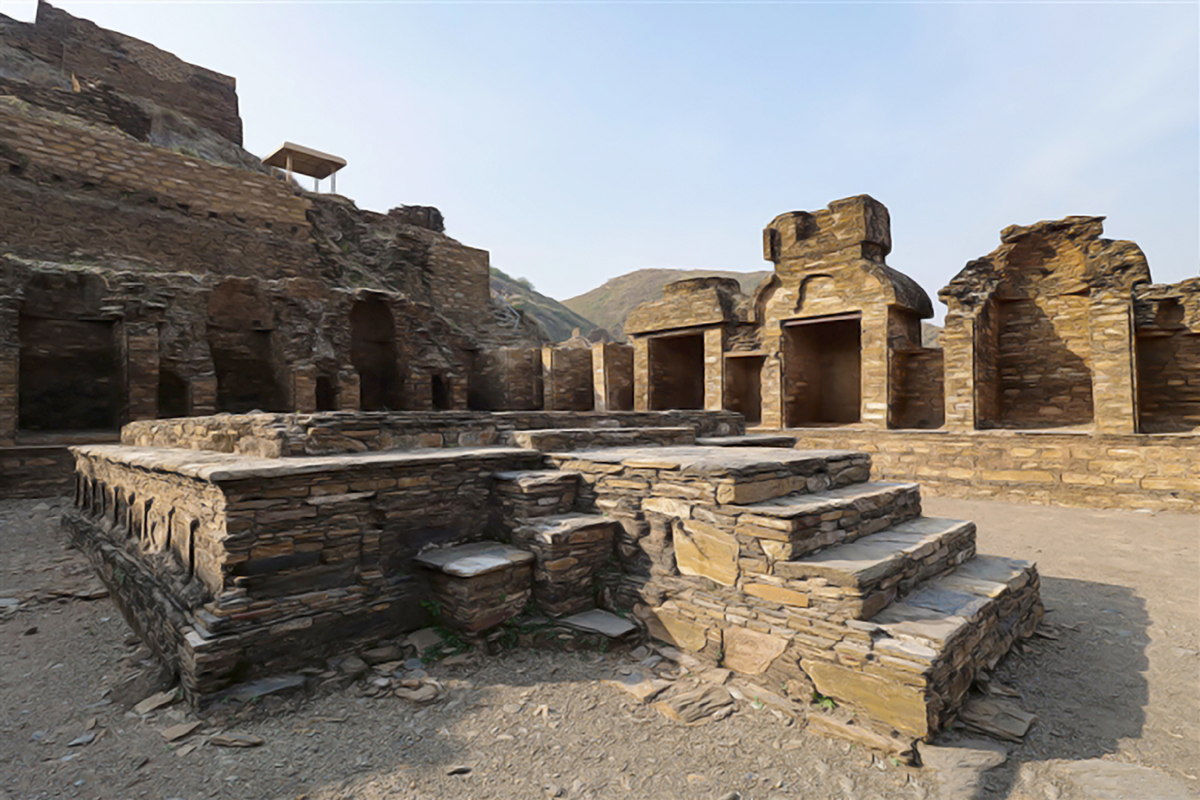A cultural crossroads of ancient South Asia
By Interaction Team
Gandhara is an ancient Indo-Aryan civilization that flourished in the northwestern regions of present-day Pakistan and northeastern Afghanistan. Its heartland included the Peshawar and Swat valleys, stretching across the Indus River to Taxila in the Potohar Plateau and into Afghanistan’s Kabul Valley, all the way up to the Karakoram Range.
It shared borders with Bactria (an ancient Iranian civilization in Central Asia), Ariana (a district extending between Central Asia and the Indus River), Arachosia (a part of the Achaemenid Empire mainly centered around the Arghandab River, Afghanistan), and Sattagydia (an area from the east of the Sulaiman Mountains up to the Indus River in the Bannu basin, KP), making it a vital crossroads for various civilizations.
This kingdom had capitals at different locations, including Kapisi (Bagram), Pushkalavati (Charsadda), Taxila, Puruṣapura (Peshawar), and eventually Udabhandapura (Hund) along the River Indus. The name “Gandhara” finds its roots in various ancient languages, but it is primarily derived from the Sanskrit word “gandha,” meaning “perfume,” reflecting the region’s role in trading aromatic spices.
Historical roots
The roots of this civilization date back to the Vedic period (1500-500 BC), with references in sacred texts like the Rigveda, Mahabharata, and Ramayana. King Pushkarasarin’s reign around 550 BC marked a period of imperial expansion, followed by Achaemenid rule (the First Persian Empire, from 550-330 BC) and Mauryan rule (322 -185 BC). The golden era of Gandhara occurred during the Kushan Empire’s rule (1st to 5th centuries AD). The region witnessed unparalleled artistic and intellectual growth, characterized by the fusion of Hellenistic and Indian influences, leaving a rich legacy.
Gandhara gradually declined over the centuries, facing invasions from the Alchon Huns (Central Asian tribes) in the 6th century AD. However, its cultural and artistic contributions continued to influence the region until the conquest by Mahmud Ghaznavi in 1001 AD, marking the end of the Gandhara civilization. Gandhara played a pivotal role in disseminating Greco-Buddhism and Gandharan Buddhism across Central and East Asia, leaving an indelible mark on the region’s culture, language, and art.
Rediscovery
In the 19th century, British interest in the region led to significant discoveries, including coins from the post-Ashoka period in the 1830s. Archaeologists like Charles Masson, James Prinsep, and Alexander Cunningham deciphered the Kharosthi script and identified numerous Buddhist shrines. In 1848, Cunningham discovered Gandhara sculptures, and he located Taxila in the 1860s. Between 1912 and 1934, archaeologist John Marshall’s work at Taxila revealed separate Greek, Parthian, and Kushan cities, along with numerous stupas and monasteries.
After 1947, researchers such as Ahmed Hassan Dani from the University of Peshawar unearthed more findings in the Peshawar and Swat Valley, with contributions from universities worldwide.
Cultural and artistic legacy
Gandhara’s cultural legacy remains a significant part of Pakistan’s identity. Its connection to Buddhism, the spread of the religion, and the preservation of historical sites continue to be celebrated. Pakistan boasts several Buddhist archaeological sites, including UNESCO World Heritage Sites like Taxila and the ruins of Takht-i-Bahi and Sahr-i-Bahlol (Mardan, KP).
These sites contain stupas, monasteries, and sculptures, reflecting Gandhara’s historical importance. The Swat Valley in Pakistan, a part of the Gandhara Civilization, is known for its archaeological remains and Buddhist sites. The artistic legacy of Gandhara remains a source of inspiration for contemporary artists in Pakistan. The Gandharan art style, with its unique blend of Hellenistic and Indian influences, continues to captivate art enthusiasts. Buddhist sculptures from Gandhara, particularly those of the Buddha, remain essential to Pakistan’s artistic heritage.
The Gandharan style’s influence can be observed in various art forms, including contemporary interpretations of Buddhist themes. Moreover, Gandhara’s historical sites attract tourists and researchers, contributing to cultural exchange and educational opportunities in Pakistan.
Educational institutions in Pakistan, particularly in the Peshawar and Swat regions, offer research and academic programs dedicated to the study of Gandhara’s history and archaeology. Pakistan’s government collaborates with international organizations to invest in the preservation and restoration of Gandhara’s historical sites. The UNESCO World Heritage designation for Taxila and the ruins of Takht-i-Bahi and Sahr-i-Bahlol underscores the international significance of these sites. In conclusion, the reflection of Gandhara in today’s Pakistan is evident in the preservation of its cultural heritage, its enduring artistic legacy, its contribution to tourism and education, and its recognition on the global stage. As Pakistan continues to celebrate its rich history and cultural tapestry, Gandhara remains a symbol of the nation’s deep connection to its ancient past.


